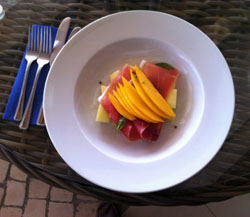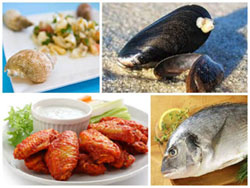Food
Food
We always stock the boat (with your dietary requirements and requests considered) in advance of your arrival so that your valuable time is not spent walking around the local supermarket! Provisions are provided for all breakfasts, lunches and 2 or 3 evening meals aboard (often home cooked and much appreciated fare!).
 On the other nights we will recommend typical inexpensive local restaurants where you can sample the local delicacies – locally caught fish usually being top of everybody’s list washed down with typical Portuguese Vino Verde. An average meal out would cost in the region of €20 including a drink.
On the other nights we will recommend typical inexpensive local restaurants where you can sample the local delicacies – locally caught fish usually being top of everybody’s list washed down with typical Portuguese Vino Verde. An average meal out would cost in the region of €20 including a drink.
We are told that in the 15th century, Prince Henry the Navigator ordered his explorers to bring back to Portugal any exotic fruits, nuts, and plants from new lands. As a result, the Age of Discovery dramatically affected cooking in Portugal and around the world. Tomatoes and potatoes were taken to Europe, Brazilian pineapples were introduced to the Azores, Brazilian chilli peppers grew in Angola, African coffee was transplanted to Brazil (today producing about half of the world’s supply), Brazilian cashews landed in Africa and India, and tea was introduced to Europeans.
Today, the Portuguese fondness for certain ingredients like cinnamon or curry powder for example, is also a legacy from this time. But other cultures had been introducing new foods to Portugal for centuries before that. The Romans (who aimed to make the Iberian Peninsula the granary of Rome) brought wheat and introduced onions, garlic, olives, and grapes. Later, the Moors were the first to plant rice, introduced figs, planted groves of lemons and oranges, and covered the Algarve province with almond trees.
Today, naturally, Portuguese food varies from region to region, but fresh fish and shellfish are found on virtually every menu. The national dish is “bacalhau,” dried, salted cod which is always stocked in the supermarket and especially popular for local holidays. The Portuguese have been obsessed with it since the early 16th century, when their fishing boats reached Newfoundland. The sailors salted and sun-dried their catch to make it last the long journey home, and today there are said to be 365 different ways of preparing it, one for each day of the year.
Grilled sardines and horse mackerel are also popular in the coastal towns, and a mixture of other types of fish is put into a stew called “Caldeirada.” The country is full of specialty seafood restaurants, many with artistic displays of lobsters, shrimp, oysters, and crabs. To try a mixture of these, have the rich seafood rice, “arroz de marisco.”
Another national dish, but made with meat, is “cozido à portuguesa,” a thick stew of vegetables with various kinds of meat. The favorite kind is pork, cooked and served in a variety of ways. Roast suckling pig (“leitão assado”) is popular in the north of the country, as are pork sausages called “chouriço” or “linguiça.”
 The most typical desserts are cinnamon-flavoured rice pudding, flan, and caramel custard, but they also often include a variety of cheese. Many of the country’s outstanding pastries were created by nuns in the 18th century, which they sold them as a means of supplementing their incomes.
The most typical desserts are cinnamon-flavoured rice pudding, flan, and caramel custard, but they also often include a variety of cheese. Many of the country’s outstanding pastries were created by nuns in the 18th century, which they sold them as a means of supplementing their incomes.
Many of their creations have interesting names like “barriga de freira” (nun’s belly), “papos de anjo” (angel’s chests), and “toucinho do céu” (bacon from heaven). A particularly delicious pastry is “pastel de nata,” a small custard tart sprinkled with cinnamon.
☎ + 351 918 513 076
☎ +44 7747 100030
Email: info@rusailing.com
rusailing Lda
Nucleo Gil Eanes
Esc 5-1, Dt Tras
Marina de Lagos,
8600-780 Lagos,
Portugal


